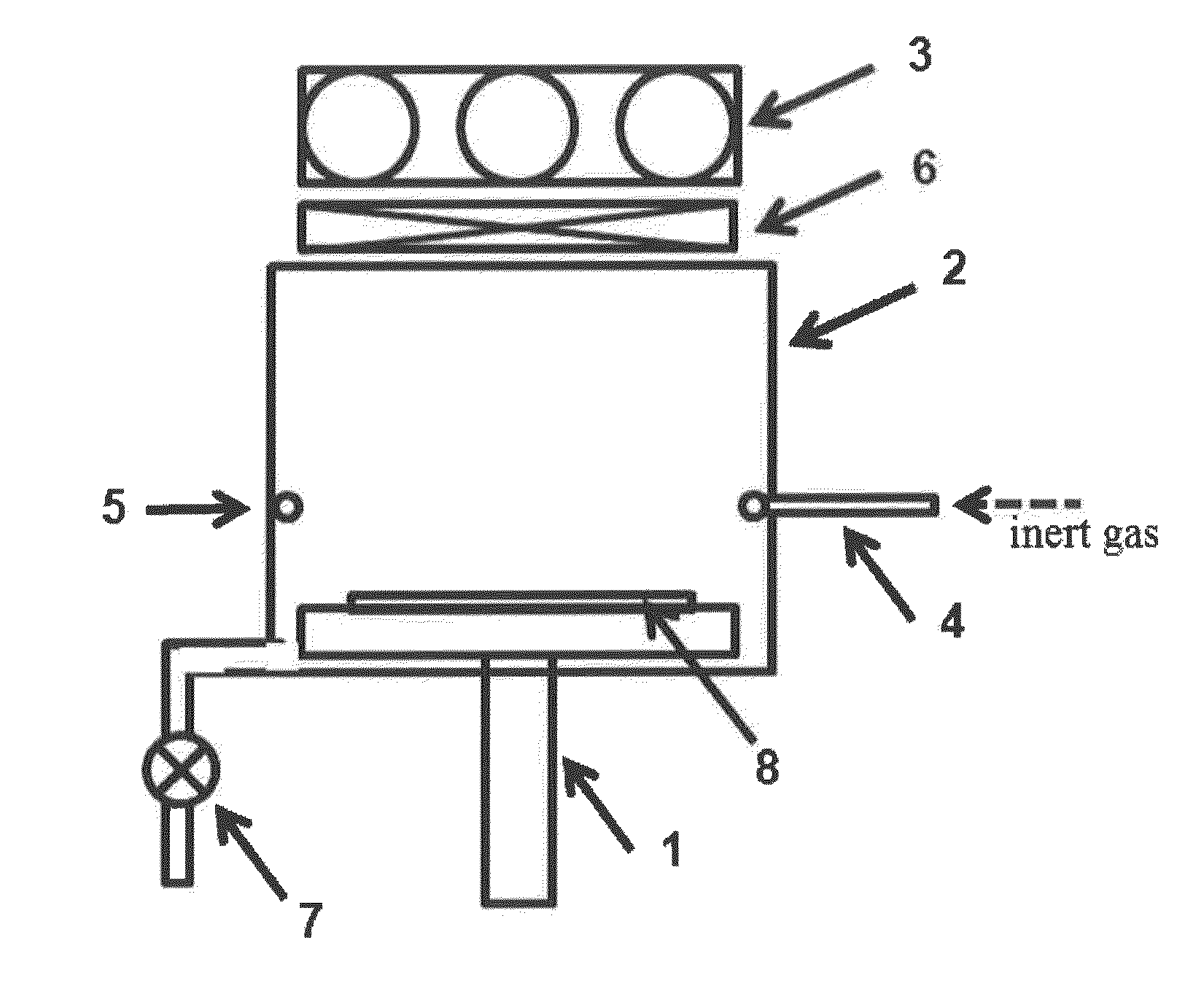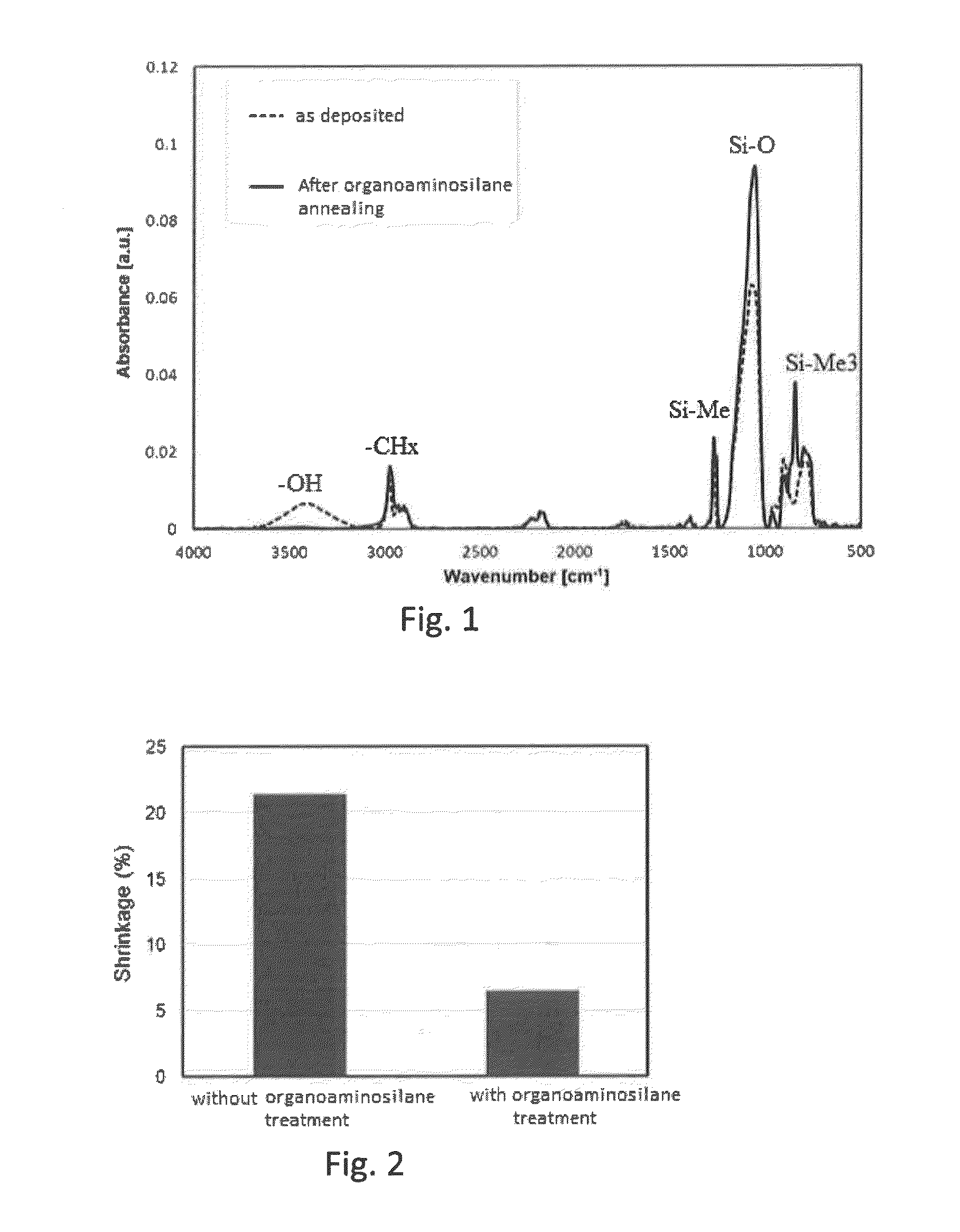Method for Forming SiOCH Film Using Organoaminosilane Annealing
a technology of organoaminosilane and film, which is applied in the direction of semiconductor/solid-state device manufacturing, basic electric elements, electric apparatus, etc., can solve the problems of large film shrinkage, increased wiring capacitance, and signal delay due to the resultant, so as to reduce the amount of components, increase the quantity of components, and high flowability
- Summary
- Abstract
- Description
- Claims
- Application Information
AI Technical Summary
Benefits of technology
Problems solved by technology
Method used
Image
Examples
example 1
[0129]In this example, a carbon-doped silicon oxide film was formed on a substrate as follows:
[0130](1) placing a patterned substrate on a lower electrode whose temperature was controlled at about 20° C. in a vacuum environment in a plasma reactor;
[0131](2) supplying about 0.3 g / min of siloxane (diethoxymethylsilane), about 40 sccm of oxidizing gas (oxygen), and about 300 sccm of rare gas (He) to the reactor and controlling the pressure in the reactor at about 300 Pa;
[0132](3) generating a plasma by applying RF power (about 13 MHz, about 100 W) to the reactor;
[0133](4) forming a gap-fill low-k film on the patterned substrate due to reaction of the gases using the plasma;
[0134](5) after evacuating the reactor, supplying about 100 sccm of a gas containing about 30% of dimethylaminotrimethylsilane in rare gas (Ar) and controlling the pressure in the reactor at about 1,200 Pa, thereby exposing the film to the dimethylaminotrimethylsilane gas for 2 minutes at a temperature of about 25° C...
example 2
[0142]Multiple substrates were continuously processed under conditions which were substantially similar to those in Example 1, using the clustered apparatus illustrated in FIG. 4, wherein each substrate was transferred between the chambers via the transfer chamber 41 so that the substrate was not exposed to the outside atmosphere. While transferring the substrates between the chambers, the pressure of the transfer chamber was adjusted at a pressure (100 to 1,500 mTorr) higher than that in the film formation chamber using nitrogen gas. As a comparative example, multiple substrates were processed under the same conditions except that the substrates were processed by batch at each chamber (25 wafers constituted one batch or lot), wherein the transfer chamber was not used so that the substrates were exposed to the outside atmosphere until all the substrates of the lot were processed.
[0143]FIG. 5 is a graph showing the relationship between thickness (a.u.) of cured film and cumulative nu...
example 3
[0145]In this example, a carbon-doped silicon oxide film was formed on a substrate as follows:
[0146](1) placing a patterned substrate on a lower electrode whose temperature was controlled at about 20° C. in a vacuum environment in a plasma reactor;
[0147](2) supplying about 0.3 g / min of siloxane (diethoxymethylsilane), about 40 sccm of oxidizing gas (oxygen), and about 300 sccm of rare gas (He) to the reactor and controlling the pressure in the reactor at about 300 Pa;
[0148](3) generating a plasma by applying RF power (about 13 MHz, about 100 W) to the reactor;
[0149](4) forming a gap-fill low-k film on the patterned substrate due to reaction of the gases using the plasma;
[0150](5) starting supplying about 1,000 sccm of oxygen (O2) and about 5,000 sccm of rare gas (Ar) to a remote plasma unit upstream of the reactor so as to supply an oxygen plasma to the reactor while controlling the pressure in the reactor at about 1,000 Pa;
[0151](6) after evacuating the reactor, supplying about 100...
PUM
 Login to View More
Login to View More Abstract
Description
Claims
Application Information
 Login to View More
Login to View More - R&D
- Intellectual Property
- Life Sciences
- Materials
- Tech Scout
- Unparalleled Data Quality
- Higher Quality Content
- 60% Fewer Hallucinations
Browse by: Latest US Patents, China's latest patents, Technical Efficacy Thesaurus, Application Domain, Technology Topic, Popular Technical Reports.
© 2025 PatSnap. All rights reserved.Legal|Privacy policy|Modern Slavery Act Transparency Statement|Sitemap|About US| Contact US: help@patsnap.com



